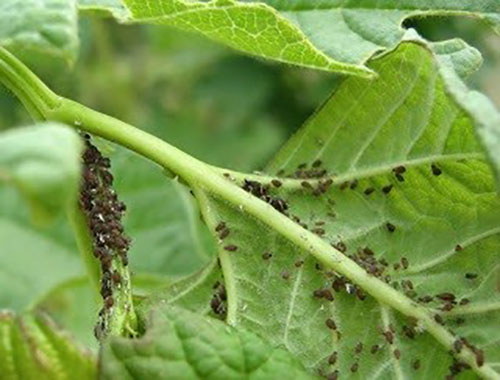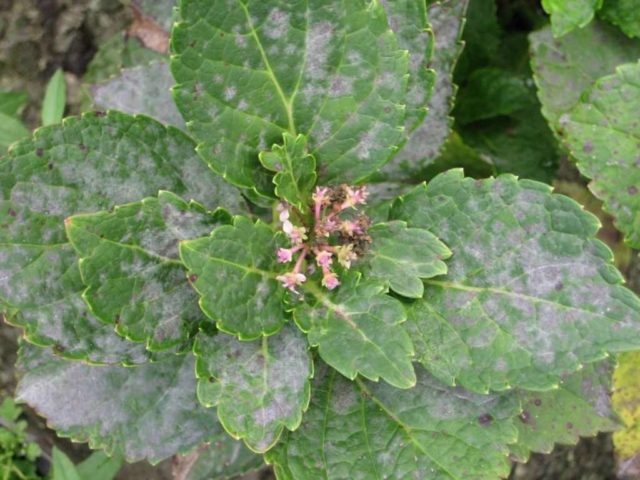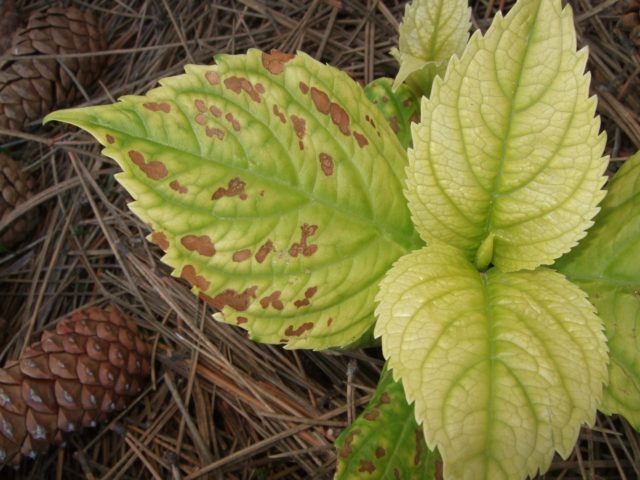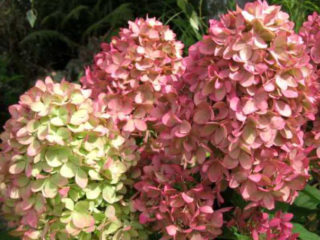Content
Hydrangea Confetti is one of the favorite ornamental plants among gardeners. And this is not surprising. It combines a lot of positive qualities: large inflorescences, pleasant colors, long flowering, unpretentious care and endurance. The main advantage of this type of hydrangea over others is that it tolerates cold well.
Description of Hydrangea Confetti
Panicle hydrangea (Latin Hydrangeapaniculata Confetti) is a low-growing ornamental bush. Its height is 1-1.5 m, and its diameter is -75 cm. The inflorescences are large, delicate, conical in shape, reaching a length of 30 cm. They are located vertically. The panicles contain many fragrant flowers.

As it blooms, the hydrangea changes color.
Confetti flowers appear in July. They are initially white and green. However, from the second week of flowering, a color change begins. The lower tiers acquire a pink tint of varying degrees of saturation. Flowering continues until September.
The leaves are dark green, oval, pointed, with pronounced veins. The stems are strong, combining a mixture of scarlet, brown and orange.
Hydrangea Confetti in landscape design
According to the description and photo of the Confetti hydrangea, it is clear that it will look harmonious both on flower beds and on lawns. Perfect for landscape compositions. It can be planted as a single bush or in groups. Combines with barberry and conifers. Suitable for outdoor cultivation, container cultivation.
Winter hardiness of hydrangea Confetti
Hydrangea Confetti is distinguished by its unpretentiousness and endurance. It is able to withstand frosts down to -30 ° C. This quality allows it to be grown not only in regions with a southern climate.
Planting and caring for Confetti panicle hydrangea
The abundance of its flowering depends on how correct the care of Hydrangea Confetti will be. Before planting young bushes (3-4 years old) in open ground, you need to decide what decorative effect will be obtained after strengthening the plants. Based on this, you need to calculate at what distance to make holes.
Selection and preparation of the landing site
Hydrangea loves nutritious, moderately moist, slightly acidic soil without lime admixture. The place for planting it must be chosen so that at lunchtime it is in partial shade. Under the bright sun, the plant feels uncomfortable, later blooms, and its inflorescences never become lush. Ideally, the Confetti hydrangea is only lit in the morning or evening.
In order for the plant to take root in a new place, a mixture is made, which includes:
- 2 parts of enriched soil;
- 2 parts of high-moor peat (for acidification);
- 1 part of humus (10 kg per 1 m2);
- 1 part of sand (to perform a drainage function, so that water does not stagnate);
- 25 g of carbamide;
- 65 g superphosphate;
- 25 g potassium sulfate;
- some needles (for acidification).
When planting, sprinkle the root system of a young bush with the finished mixture.
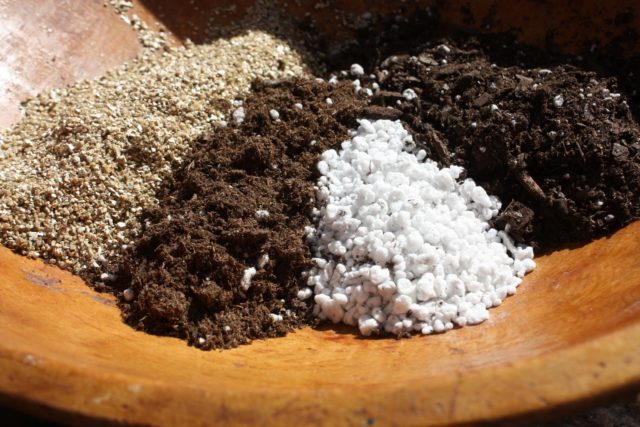
In order for the hydrangea to take root better, it is sprinkled not with earth, but with a special mixture
Landing rules
After thawing the soil, pits about 60 cm wide and 40 cm deep are dug in it.The bottom is sprinkled with soil mixture. A small layer of small stones is also laid out there. The minimum distance between the pits is 1.5 m. If it is less, the grown Confetti will interfere with each other and compete with each other for the sun's rays. Next, the diseased and dried roots will be removed from the seedling. There must be at least 3 growth buds on its stem.
The confetti is immersed in a hole and sprinkled with the rest of the soil mixture. The latter is lightly tamped. The planted young bush is generously watered and mulched. Needles or tree bark are used as mulch for Confetti. Its layer should be 8-10 cm.
Watering and feeding
Hydrangea paniculata confetti is a moisture-loving plant. It is watered twice a week. At the same time, 3 buckets of water are consumed for each adult bush. During periods of cold snap and frequent precipitation, the frequency of the procedure is reduced, and in drought, if necessary, it is increased. It is desirable that the water does not contain chlorine. Rainwater is ideal for these purposes. Some summer residents collect it in advance and store it in barrels, tubs. They try to water the Hydrangea Confetti carefully, so as not to wet the leaves and flowers.
To make the crown of Confetti lush, top dressing is periodically introduced. This is usually done during the following periods:
- in the fall, make preparations of phosphorus and potassium;
- in the spring, 20 g of urea is dissolved in a bucket of water and watered with the finished plant solution;
- during the growing season, 8-10 liters of manure are poured under each plant.
In addition, there is a recipe for feeding that stimulates the abundant flowering of a young hydrangea bush. They make it like this: 30 g of potassium sulfate is mixed with 30 g of urea and 30 g of superphosphate. The resulting mixture is dissolved in a bucket of water. The maximum dosage is 3 buckets.
Pruning Hydrangea Confetti
Pruning the Confetti bush is done twice:
- in the fall, wilted inflorescences are removed;
- in the spring, diseased, dry branches are cut.
In the summer months, if necessary, thinning of the bush is carried out and its shape is corrected. This allows you to achieve the most aesthetic appearance. When removing shoots, be sure to leave at least 4 growth buds for the further development of the plant.
Preparing for winter
Despite the fact that Confetti easily tolerates the cold, after pruning, the hydrangea is prepared for winter. They do it like this:
- The plant is wrapped with insulation.
- Above it, a structure is created from a base and a mesh coating, and the inner void is closed with dry fallen leaves.
- From above, the mesh with the frame is covered with a dense, waterproof film.
So it is possible to create a favorable microclimate around the Confetti hydrangea and save it from icing in the event of a sharp temperature drop.

Despite the fact that Confetti is a cold-resistant variety, it still needs to be insulated for the winter.
Reproduction
Hydrangea flowers are sterile and do not participate in the sexual reproduction of the plant. Therefore, gardeners propagate the bushes by the following methods:
- By cuttings. The procedure involves harvesting hydrangea cuttings before the tissues begin to harden (June). The cuttings are immersed in water, they are in it until roots appear. After the end of the adaptation period, the young plant is planted in a permanent place.
- By dividing the bush. An adult hydrangea is divided into several young bushes.
- Layers. The confetti shoot is bent to the ground and fixed. This method is the least effective.
When transplanting hydrangeas, you need to dig out young bushes with a lump of soil. This will avoid damage to the root system. The main advantage of asexual reproduction of plants is that it allows you to fully preserve the qualities of the mother. This means that the mother and the young bush will be one-on-one with each other.
The roots should be placed in a plastic bag and several handfuls of peat and raw sawdust should be poured into it. It is necessary to ensure that the roots of the young bush do not dry out.
Diseases and pests
When growing hydrangeas, you can face a number of problems, especially often with young bushes.
These are, first of all:
- Spider mite attack... The pest infects the lower part of the leaf and braids it with brown cobwebs. As a result, it turns yellow, and then dries up and falls off. At an air temperature of 30 ° C and a humidity of 40-50%, its development cycle takes a week. At an air temperature of 10 ° C and a humidity of 85%, its activity decreases. The problem is eliminated by spraying the bushes with thiophos (7 g per bucket of water).
The pest gives up to 12 generations per year
- Aphid attack. In closed ground, when forcing plants, an attack of green leaf aphids is possible. To combat it, anabazine sulfate solution is used (15 g of the substance is diluted in a bucket of water). Confetti is sprayed with it twice.
When attacked by aphids, the leaves begin to wilt immediately.
- Downy mildew. Its main feature is oily spots on the leaves, which gradually turn yellow and darken, increase in size. A yellow bloom forms on the lower part of the leaves. It is often present on the stems. The pathological process develops most actively when the air temperature is around 20 ° C and excessive humidity. To eliminate the problem, the leaves are treated with 150 g of green soap, 15 g of copper sulfate and a bucket of water.
The pathological process affects the leaves and stems of Confetti
- Chlorosis. The main symptom of the pathological process is the clarification of the leaves. Only the veins on them retain their color. Frequent application of humus can lead to a problem. To cure a hydrangea from chlorosis, it must be poured three times with a solution of potassium nitrate (40 g of funds per bucket of water), and three days later with a solution of ferrous sulfate (also 40 g per bucket of water).
Confetti, which grow in soil with a high content of lime, most often suffer from chlorosis.
Conclusion
Hydrangea Confetti is a vivid representative of a culture that can not only delight the eye with bright beautiful flowers, but also surprise with a change in the color of the petals during flowering. The plant is not whimsical at all. Caring for it includes regular watering and feeding, pruning sick and old branches, warming for the winter. Even a beginner can cope with this task.

